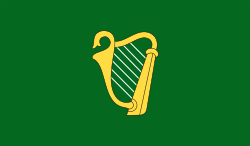Irish commandos
| Irish commandos | |
|---|---|
 Flag of the Irish Transvaal Brigade and all Irish Boer volunteers which was synonymous with the emancipation and independence of Ireland from rule under the British Empire | |
| Active | 1899–1902 |
| Country |
|
| Allegiance |
|
| Branch |
Boer Army - Boer foreign volunteers
|
| Type | Commandos |
| Role | Guerilla warfare |
| Size | 150 |
| Engagements | Second Boer War |
| Commanders | |
| Notable commanders |
General Lukas Meyer Arthur Lynch |
Two Irish Commandos volunteer military units of guerilla militia fought alongside the Boers against the British forces during the Second Boer War (1899–1902).
Irish Transvaal Brigade
The Irish Transvaal Brigade, also known as the Wreckers' Corps, was organised by John MacBride, who was then employed at the Band Mines. Most of the battalion-strength Brigade were Irish or Irish-American miners living in the Transvaal who were willing to fight with the Boers against the British. The Brigade was bolstered during its campaign by a contingent of volunteers who came from Chicago and by a variety of Irish volunteers who travelled from America and Ireland for the purposes of joining the Brigade.[1]:66, 68, 71
Irishmen on the side of the British Army also fought in the Boer War, which symbolised one of many moments in Irish history in which Irishmen had divided localities. That ultimately led to them fighting each other.
John MacBride wrote his own account of the Irish Transvaal Brigade, which can found in Anthony J. Jordan's edited version of the writings of MacBride.[1]:1–79
The Brigade would come to be known as MacBride's Brigade, after their commander, John MacBride. It was operational from September 1899 to September 1900, when the brigade fought in about 20 engagements, with 18 men killed and about 70 wounded from a complement of no more than about 300 men at any one time. When it disbanded, most of the men crossed into Mozambique, which was a colony of neutral Portugal. Colonel John Y. F. Blake, a former US Army officer was the brigade's commander. When he was wounded, his second-in-command, Major John MacBride, took command.[2][3]
Prior to the Siege of Ladysmith, the commandos were involved in guarding the artillery under Carolus Johannes Trichardt. The brigade also provided signal service at the Battle of Modderspruit.[3]
At the Siege of Ladysmith, they serviced the famous Boer artillery piece, called Long Tom, and they fought at the Battle of Colenso. Having worked in the gold mines, they had a well-deserved reputation as demolition experts. They delayed the British advance on Pretoria by blowing up bridges. The brigade disbanded after the Battle of Bergendal.[3]
The brigade received letters of thanks before they left South Africa from State Secretary F. W. Reitz, Comdant-General Louis Botha and General Barend Viljoen.[1]:79
Second commando
The Second Irish Brigade was formed in January 1900 by former members of the Irish Transvaal Brigade. Former Le Journal correspondent Arthur Lynch was appointed as the unit's commander. The brigade consisted of 150 commandos from a variety of ethnic backgrounds. Including among others Irish, Australian, Greek, German, Boer and Italian members.[3]
The brigade remained attached to General Lukas Meyer's command in Natal, retiring to Laing's Nek after the siege of Ladysmith. The brigade fought in the rear guard, during the retreat from Ladysmith to Glencoe. The brigade was later ordered to Vereeniging but was disbanded while it was in Johannesburg. After the dissolution of the brigade, Lynch together with a small group of Irishmen joined various commandos along the Vaal River.[3]